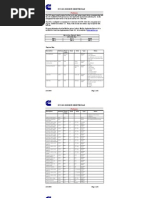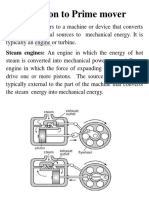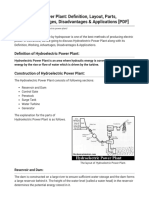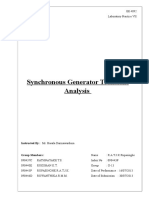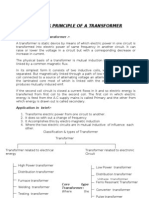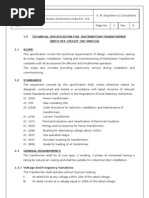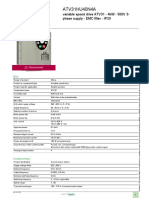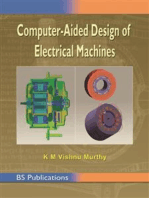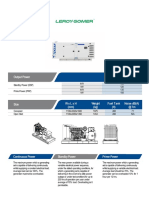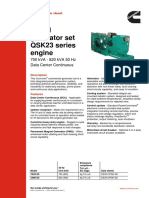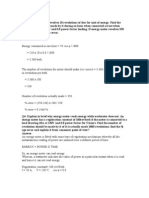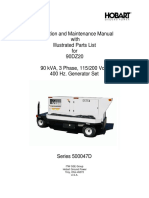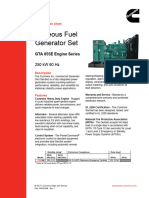Reverse Power Relay
Reverse Power Relay
Uploaded by
Řỗ Ðê ČỗňŝťãňčẹCopyright:
Available Formats
Reverse Power Relay
Reverse Power Relay
Uploaded by
Řỗ Ðê ČỗňŝťãňčẹOriginal Title
Copyright
Available Formats
Share this document
Did you find this document useful?
Is this content inappropriate?
Copyright:
Available Formats
Reverse Power Relay
Reverse Power Relay
Uploaded by
Řỗ Ðê ČỗňŝťãňčẹCopyright:
Available Formats
Why reverse power relays are used for protection of parralled alternators? Is direction of alternator changed.
If reverse power relay does not works what damages will be occured with respect to all machineries, what will happen to direction of alternator when changes to motor situation?
The reverse power relay prevents an alternator from becoming a motor. Once connected to the busbar, an alternator or synchronous generator will always run at the speed/frequency of the
grid. If the throttle/steam valve has been advanced or opened from synchronous or no-load speed, it exerts torque against the rotor in the forward direction which generates electricity. If the
throttle position is below synchronous or no-load speed, it is "Motorized" or driven in the same direction as before, except that energy now has to be supplied to the alternator from the grid to
keep the same speed (A waste of energy, and not what is intended at all).
The reverse power relay watches voltage and current to ensure this does not happen. If the generator/alternator begins to be motorized, the reverse power relay trips the generator breaker so
no damage to either system occurs.
One problem is that running a generator as an electric motor is horribly wasteful. Driving the whole valve train or turbine rotor with purchased power is never intentional, and can only occur if
there is a problem with some part of the control system. Damage can occur to the engine or turbine because it is not designed to be a driven element
Reverse Power Relay - Function and Operation
A reverse power relay is a directional power relay that is used to monitor the power from a generator running in parallel with another generator or the utility. The
function of the reverse power relay is to prevent a reverse power condition in which power flows from the bus bar into the generator. This condition can occur when
there is a failure in the prime mover such as an engine or a turbine which drives the generator.
Causes of Reverse Power
The failure can be caused to a starvation of fuel in the prime mover, a problem with the speed controller or an other breakdown. When the prime mover of a
generator running in a synchronized condition fails. There is a condition known as motoring, where the generator draws power from the bus bar, runs as a motor
and drives the prime mover. This happens as in a synchronized condition all the generators will have the same frequency. Any drop in frequency in one generator
will cause the other power sources to pump power into the generator. The flow of power in the reverse direction is known as the reverse power relay.
Another cause of reverse power can occur during synchronization. If the frequency of the machine to be synchronized is slightly lesser than the bus bar frequency
and the breaker is closed, power will flow from the bus bar to the machine. Hence, during synchronization(forward), frequency of the incoming machine is kept
slight higher than that of the bus bar i.e. the synchroscope is made to rotate in the "Too fast" direction. This ensures that the machine takes on load as soon as the
breaker is closed.
Setting the Reverse Power Relay
The reverse power relay is usually set to 20% to 25% of the motoring power required by prime mover. By motoring power we mean the power required by the
generator to drive the prime mover at the rated rpm. This is usually obtained from the manufacturer of the prime mover (turbine or engine).
You might also like
- A Study On AptranscoDocument6 pagesA Study On AptranscoshaheedaazmaNo ratings yet
- WILO IL-IS ManualDocument18 pagesWILO IL-IS Manualpaul czNo ratings yet
- Iiee Device Numbers and Functions For Switchgear ApparatusDocument23 pagesIiee Device Numbers and Functions For Switchgear Apparatusair rulerNo ratings yet
- Single Line PowerDocument10 pagesSingle Line PowerDian PrasetyawanNo ratings yet
- PCC1301 Modbus Register Map - Cph031105Document8 pagesPCC1301 Modbus Register Map - Cph031105Gabriel CarvalhoNo ratings yet
- Reverse PowerDocument5 pagesReverse PowerAmirmasoudNo ratings yet
- 002 LD SD 02Document11 pages002 LD SD 02marab12No ratings yet
- Maintenance of TransformerDocument8 pagesMaintenance of TransformeranilsinghteslaNo ratings yet
- p1 - EEE Interview QuestionsDocument4 pagesp1 - EEE Interview Questionsjabrukesh31No ratings yet
- Prime Mover Refers To A Machine or Device That ConvertsDocument8 pagesPrime Mover Refers To A Machine or Device That ConvertsАбдельнасир АбдельрахманNo ratings yet
- ELECTRICAL Engineering Interview Questions With Answers Free Download - EEEDocument33 pagesELECTRICAL Engineering Interview Questions With Answers Free Download - EEEearhyathNo ratings yet
- DC GeneratorDocument31 pagesDC GeneratorMd Rasheduzzaman Al-AminNo ratings yet
- Electrical Concepts: Anti Pumping Relay in Circuit BreakerDocument3 pagesElectrical Concepts: Anti Pumping Relay in Circuit BreakerSureshraja9977No ratings yet
- What Are Turbines ? - Types of Turbines & Their ApplicationsDocument6 pagesWhat Are Turbines ? - Types of Turbines & Their ApplicationsAnonymous m2GmeVnY100% (1)
- Eee Interview Questions and Answers PDF - Indianitjobs4uDocument10 pagesEee Interview Questions and Answers PDF - Indianitjobs4ugangadharan000No ratings yet
- Hydroelectric Power Generation Notes (Publication by Electroogle - Blogspot.com)Document10 pagesHydroelectric Power Generation Notes (Publication by Electroogle - Blogspot.com)Usman UmarNo ratings yet
- Manual Instruciton NGRDocument4 pagesManual Instruciton NGRAhmad Ikhsan KurniantoNo ratings yet
- Hydroelectric Power Plant - Definition, Layout, Parts, Working, Advantages, Disadvantages & Applications (PDF)Document5 pagesHydroelectric Power Plant - Definition, Layout, Parts, Working, Advantages, Disadvantages & Applications (PDF)sureshNo ratings yet
- Air Blast Circuit BreakerDocument3 pagesAir Blast Circuit BreakerBishal Das100% (1)
- Why Star Delta Starter Is Preferred With Induction MotorDocument4 pagesWhy Star Delta Starter Is Preferred With Induction MotorsujithNo ratings yet
- Classification of RelaysDocument13 pagesClassification of RelaysGideon MoyoNo ratings yet
- A Survey On Slip Power Recovery DrivesDocument9 pagesA Survey On Slip Power Recovery Drivesesaivanan1150% (2)
- Introduction To Turbo GeneratorDocument42 pagesIntroduction To Turbo GeneratorTirumalesh ReddyNo ratings yet
- Lecture 6a - VVVF IM Speed ControlDocument8 pagesLecture 6a - VVVF IM Speed Controlvijaykumar_aluriNo ratings yet
- Single Phase Motors NotesDocument9 pagesSingle Phase Motors NotesMohit IndurkarNo ratings yet
- Electrical Interview BreakersDocument4 pagesElectrical Interview Breakersmolinetariro1No ratings yet
- G5 Series User ManualDocument22 pagesG5 Series User ManualDaniel MekonnenNo ratings yet
- Power System PresentationDocument10 pagesPower System PresentationBayeNo ratings yet
- 3 Phase Motor Programmable Controller Report 2Document3 pages3 Phase Motor Programmable Controller Report 2Solomon VargheseNo ratings yet
- Lecture 3 Slides On Electric Machinery Fundamentals (Chapter 1 of Chapman)Document17 pagesLecture 3 Slides On Electric Machinery Fundamentals (Chapter 1 of Chapman)Mubarrat Hossain SaminNo ratings yet
- Fdocuments - in 220 KV Gss Heerapura Report 558448df06729Document45 pagesFdocuments - in 220 KV Gss Heerapura Report 558448df06729Bharat Kumar PrajapatiNo ratings yet
- What Is The Difference Between MCB MCCB ELCB and RCCB PDFDocument7 pagesWhat Is The Difference Between MCB MCCB ELCB and RCCB PDFMrinal Kanti RoyNo ratings yet
- Speed Control IM (Edited)Document37 pagesSpeed Control IM (Edited)مصطفى حمدى100% (1)
- Slip Ring Induction Motor Drive With Slip Recovery Using IGBTDocument2 pagesSlip Ring Induction Motor Drive With Slip Recovery Using IGBTmahesh-pati-6768No ratings yet
- Question 1 (Problem 2-5 in The Text)Document5 pagesQuestion 1 (Problem 2-5 in The Text)Racheal KirbyNo ratings yet
- Synchronous Generator Transient AnalysisDocument11 pagesSynchronous Generator Transient AnalysisSBNSSenanayakeNo ratings yet
- EUE Lab - ManualDocument65 pagesEUE Lab - Manualjabin miykael100% (1)
- Engineers, I Need Advice, Please Help - Tripping of MV Switchgear When Transformer Breaker Is Closed in The RMUDocument8 pagesEngineers, I Need Advice, Please Help - Tripping of MV Switchgear When Transformer Breaker Is Closed in The RMUAbdulyunus AmirNo ratings yet
- Ee 591 Machine 2 PDFDocument39 pagesEe 591 Machine 2 PDFPrabhat Kumar SahuNo ratings yet
- 090443P - Synchronous Generator Transient AnalysisDocument16 pages090443P - Synchronous Generator Transient AnalysisManoj JayaruwanNo ratings yet
- 220 KV GSS Heerapura ReportDocument43 pages220 KV GSS Heerapura ReportNitin Bhardwaj100% (2)
- Eue-Lab Final See2Document29 pagesEue-Lab Final See2Harsha Samagara100% (1)
- Zungeru Swithcyard Communication SystemDocument30 pagesZungeru Swithcyard Communication Systemrotimi olalekan fatai100% (1)
- 2015 Summer Model Answer PaperDocument30 pages2015 Summer Model Answer PaperRohit BariNo ratings yet
- 2 Zungeru Switchyard DC SystemDocument91 pages2 Zungeru Switchyard DC Systemrotimi olalekan fataiNo ratings yet
- Harmonics NotesDocument9 pagesHarmonics NotesKINGSCOMPUTERS CYBERNo ratings yet
- Circuit Breakers MaintenanceDocument78 pagesCircuit Breakers MaintenanceAldo Sempértegui TapiaNo ratings yet
- Working Principle of A TransformerDocument4 pagesWorking Principle of A TransformerGyan BshnNo ratings yet
- Modelling and Design of Hydraulic Turbine - Governor SystemDocument5 pagesModelling and Design of Hydraulic Turbine - Governor SystemJaime L. ReyesNo ratings yet
- RN - Transformer Spec.Document21 pagesRN - Transformer Spec.ddhar633No ratings yet
- Power System Protection-2Document49 pagesPower System Protection-2IsaacNo ratings yet
- Designdcmc - DR Jamnani-PDPU (Compatibility Mode)Document45 pagesDesigndcmc - DR Jamnani-PDPU (Compatibility Mode)Harsh Thakur100% (1)
- IM Faults and RemediesDocument10 pagesIM Faults and Remediesdattatray kulkarni100% (1)
- Altivar 31 - ATV31HU40N4ADocument3 pagesAltivar 31 - ATV31HU40N4Avendas.ilimitadasNo ratings yet
- Information On Electrical BrakingDocument5 pagesInformation On Electrical Brakingelectricalfren100% (2)
- Disconnect and Earth Switch TestDocument2 pagesDisconnect and Earth Switch TestNAGARAJNo ratings yet
- Internship Report FOR AP GENCODocument65 pagesInternship Report FOR AP GENCORajesh KalyanamNo ratings yet
- Power Factor CorrectionDocument8 pagesPower Factor CorrectionNarendraNo ratings yet
- Soft StarterDocument6 pagesSoft StarterEric Maglinte TolosaNo ratings yet
- Manual de Armado 830E1 A-C PDFDocument400 pagesManual de Armado 830E1 A-C PDFCarlos Rolando Lopez Chavez50% (2)
- PERKINS 150 kVADocument2 pagesPERKINS 150 kVAАндрейNo ratings yet
- Genco-Transco Prev PapersDocument257 pagesGenco-Transco Prev PaperssivaNo ratings yet
- Low Voltage Alternator - 4 Pole: Installation and MaintenanceDocument28 pagesLow Voltage Alternator - 4 Pole: Installation and MaintenanceAllen AnyayahanNo ratings yet
- Agg Af22d5Document4 pagesAgg Af22d5Olieev LepageNo ratings yet
- P8 H1 Perkins 403d 11gDocument9 pagesP8 H1 Perkins 403d 11gMyatmin htetwaiNo ratings yet
- Final Year PapDocument8 pagesFinal Year PapSanioSunojNo ratings yet
- 932-1005 Detector Participants GuideDocument140 pages932-1005 Detector Participants Guide032359rw100% (6)
- Electric Machine Basics: Is Called Stator Is Called RotorDocument10 pagesElectric Machine Basics: Is Called Stator Is Called RotorSatrio WibowoNo ratings yet
- ThermoelectricDocument56 pagesThermoelectricYaqoob AhmadNo ratings yet
- AC550Document5 pagesAC550mhmmd14No ratings yet
- SS12 CPGK DC50 PDFDocument4 pagesSS12 CPGK DC50 PDFTDH OfficialNo ratings yet
- Altronicv Small Engines, 1-6 Cylinders Service Manual Form Av SM 12-96Document15 pagesAltronicv Small Engines, 1-6 Cylinders Service Manual Form Av SM 12-96Clever Negrete NovaNo ratings yet
- Electrical InstrumentsDocument19 pagesElectrical InstrumentsLakshmi Priya Palaniappan100% (1)
- The Science Behind Stanley Meyer Water Powered CarDocument31 pagesThe Science Behind Stanley Meyer Water Powered CarMilan MilenkovićNo ratings yet
- Matlab Code Alternator Optimization PDFDocument278 pagesMatlab Code Alternator Optimization PDFNajam Ul QadirNo ratings yet
- Fyp Manufacturing Design Insulation SystemDocument105 pagesFyp Manufacturing Design Insulation SystemMuhammad AsifNo ratings yet
- Om 2076DDocument222 pagesOm 2076DJuanmanuel Barroyeta100% (1)
- Leroy Somer r230 Automatic Voltage RegulatorDocument12 pagesLeroy Somer r230 Automatic Voltage RegulatorGiapy Phuc TranNo ratings yet
- Vibration Diagnostic ChartDocument49 pagesVibration Diagnostic ChartMuhammad afzalNo ratings yet
- Caterpillar Generator Data Production (Washaap15)Document8 pagesCaterpillar Generator Data Production (Washaap15)meplanka infoNo ratings yet
- Open Ended LabDocument8 pagesOpen Ended LabIHZAM ZIANo ratings yet
- Figure GeneratorDocument5 pagesFigure GeneratorTao Moustapha OumarouNo ratings yet
- Wdg4, p4 ElectricalDocument74 pagesWdg4, p4 ElectricalHanuma ReddyNo ratings yet
- EH1100 (3) Electrical Training Manual - HTT1100 (3) - 20-0409Document46 pagesEH1100 (3) Electrical Training Manual - HTT1100 (3) - 20-0409jc villongco100% (2)
- Marathon MotorDocument30 pagesMarathon Motormanj_bnNo ratings yet
- AC Generator (Alternator) - Construction and WorkingDocument4 pagesAC Generator (Alternator) - Construction and WorkingSACHIN SINGHNo ratings yet
- Karan Dahiwale JiDocument5 pagesKaran Dahiwale JiKaran The KDNo ratings yet
- Evolution of Power System StructureDocument11 pagesEvolution of Power System StructureHamdanie ImpaNo ratings yet




